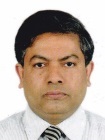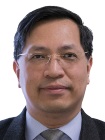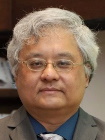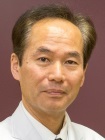

No. 125 (December 2019)
APSR News
Prof Kwun Fong

Dr Fong
As the leading item this month, we extend hearty thanks to Professor Kwun Fong who is now the APSR's immediate past president.
Prof. Fong has an exceptionally long history of dynamic activity within the APSR, invariably avoiding the spotlight, giving credit to others for his achievements. His three years as APSR president followed two years as secretary general, chair of several important APSR committees such as the Central Congress Committee and the APSR Steering Committee, head of the Lung Cancer Assembly, head of the Cell and Molecular Biology Assembly, and more.
For the direct benefit of members he has encouraged several internationally-renowned experts to fund new awards to help early-career researchers; constantly looked at ways to minimise membership dues; ensured only the most suitably qualified leaders were appointed as committee chairs; and kept a close scrutiny on the content of congress programmes.
He has formulated several initiatives during his long tenure, such as the succession planning for assembly heads and committee chairs, a timeline of the APSR's progress, the opportunity for you to publicly pay tribute and acknowledge your mentors and teachers though the APSR Members' Honour Roll, regular newsletters from the assemblies, the Teaching Library, the increasingly-referenced Asia-Pacific health map, improvements to the APSR website, and has been a willing advisor to the APSR Secretariat with invaluable guidance.
In the global arena Prof. Fong has strengthened relationships and collaboration with other international societies, such as the ATS and ERS, by promoting inter-society cooperation with assemblies and production of joint position statements. His indefatigable energy has extended to other international entities such as FIRS where he has energetically promoted the various World Days and the Charter For Lung Health.
All this, plus his own important clinical work and mentoring, has been his great contribution to respiratory health in the Asia-Pacific and beyond.
Mongolia

Mongolia is witnessing a surge in its population, thanks to fantastic improvements in general health, yet it remains the least densely populated nation in the world with just 2 people per square kilometre (5 people per square mile). It also boasts the bluest sky with 260 sunny days a year, which sounds idyllic until we remember the average temperature is -1°C, dropping to -30°C and below in winter.
This makes Ulaanbaatar one of the coldest capital cities in the world. But unlike wealthier freezing capitals such as Moscow and Toronto, heat and electricity is produced by archaic facilities and unsustainable methods which contribute to fine particle pollution and significant occupational hazards (dust induced chronic bronchitis or pneumoconiosis www.ncbi.nlm.nih.gov/pmc/articles/PMC2322933).
Efforts are being made to improve the nation's health by societies such as the Mongolian Respiratory Society who have recently joined the APSR as an en bloc member.
We will report on their news as soon as it's received and you can look forward to mutual benefits by collaborating with your peers from this fascinating country.
New layout

New Year approaches — a traditional time for changes for the better.
Until last month Bulletin issues opened with dizzying carousel, where each picture linked to an item. This issue of the Bulletin has a much simpler heading - quicker to find what you want to see.
The aim, as always, is to present the best information in the best way, and this month we offer an open invitation for YOU to suggest some fresh ideas.
Not only ideas for the Bulletin's layout, but more importantly, the content. What would you like to see? How would you like to see it?
Please send your ideas to bulletin@apsresp.org or APSRinfo@theapsr.org. We are looking forward to hearing from you.
New APSR officers, assembly leaders and other appointments
Several officers have completed their terms and others have taken up their posts. The webpage of the APSR leadership apsresp.org/about/leadership.html will be updated as soon as details are known and a full list of changes will be shown in the next Bulletin.
New assembly leaders are shown below, as are the new members of the Education Committee.

Dr Rhee
We cordially welcome Dr Chin Kook Rhee who has joined the Bulletin as a coordinator. Along with Dr Azuma, Dr Rhee will be delighted to receive any news about your society, and in particular, respiratory health news from your region.
We are keen to keep all respirologists in the Asia-Pacific region up to date with the latest news which affect their work with their patients, and can achieve this with your help.
All published submissions will give full credit to the submitter and the source.

Dr Campomanes
In the September Bulletin we invited nominations to co-chair the Industry Taskforce.
We are delighted to announce that Dr Celeste Mae Lardizabal Campomanes has been selected for this important role and she will begin her 2-year term on 1 January 2020 until the close of the APSR 2021 Seoul Congress.

New assembly leaders
Changes have taken place in the leaderships of several assemblies. Some leaders have retired after serving their term of office and the APSR is deeply indebted for their tireless voluntary activities.
Where assembly heads have retired, heads-elect have taken their places. Pleas continue to support these new heads.
And finally, we welcome new members to the assembly leadership, with a sincere hope they will enjoy the success they help bring to the assemblies.
(If you are not a member of an assembly yet, apply to join now!)
The following leaders have now retired:
 | Dr Yun Wing Thomas Mok Retiring Head of Clinical Respiratory Medicine Assembly |
 | Dr Yasuo Morimoto Retiring Head of Environmental & Occupational Health and Epidemiology Assembly |
 | Dr Kozo Kuribayashi Retiring Deputy Head of Environmental & Occupational Health and Epidemiology Assembly |
 | Dr Ki-Suck Jung Retiring Head of Respiratory Infections (non-tuberculous) Assembly |
 | Dr Soon Hin How Retiring Deputy Head of Respiratory Infections (non-tuberculous) Assembly |
 | Dr Chong Kin Liam Retiring Head of Lung Cancer Assembly |
 | Dr Peter Gibson Retiring Head of Asthma Assembly |
 | Dr Christopher Kim-Ming Hui Retiring Head-Elect of Respiratory Neurobiology and Sleep Assembly |
 | Dr Rodolfo Roman Tupas Bigornia Retiring Head of Critical Care Medicine Assembly |
 | Dr Pyng Lee Retiring Head of Bronchoscopy and Interventional Techniques Assembly |
The assembly leaders (effective from 18 November 2019) are as follows:
Clinical Respiratory Medicine
Head Dushantha Madegedara |
Head-Elect Roland Leung |
Deputy-Head Chao-Chi Ho |
Cell and Molecular Biology
Head Takahide Nagase |
Head-Elect Tomoaki Hoshino |
Deputy Head Chul-Gyu Yoo |
Environmental & Occupational Health and Epidemiology
Head Woo Jin Kim |
Head-Elect Kazuhiro Yatera |
Deputy Head Jun-Pyo Myong |
Respiratory Infections (non-tuberculous)
Head Yuanlin Song |
Head-Elect Chieh-Liang Wu |
Deputy Head Masaki Fujita |
COPD
Head Kazuto Matsunaga |
Head-Elect Chin Kook Rhee |
Deputy Head Hao-Chien Wang |
Lung Cancer
Head Emily Stone |
Head-Elect Laksmi Sita Andarini |
Deputy Head David Chi-Leung Lam |
Asthma
Head Kang-Yun Lee |
Head-Elect Phuong Phan Thu |
Deputy Head Shih-Lung Cheng |
Respiratory Neurobiology and Sleep
Head Yoshitaka Oku |
Head-Elect Ning-Hung Chen |
Deputy Head Hiromasa Ogawa |
Bronchoscopy and Interventional Techniques
Head Fumihiro Asano |
Head-Elect Phan Nguyen |
Deputy Head Chih-Yen Tu |
Paediatric Lung Disease
Head Jessie Anne de Bruyne |
Head-Elect Anna Marie Nathan |
Deputy Head Anne Goh |
Respiratory Structure and Function
Head Hajime Kurosawa |
Head-Elect Greg King |
Deputy Head Tsuyoshi Oguma |
Pulmonary Circulation
Head Nobuhiro Tanabe |
Head-Elect Masayuki Hanaoka |
Deputy Head Talant Sooronbaev |
Interstitial Lung Disease
Head Arata Azuma |
Head-Elect Takafumi Suda |
Deputy Head Moo Suk Park |
Respiratory Updates
The November issue (Vol 11.11) features 2019 Selected Educational Publications in Respirology:
- Real-life effectiveness of inhaler device switch from dry powder inhalers to pressurized metred-dose inhalers in patients with asthma treated with ICS/LABA.
- Increased risk of major adverse cardiac events following the onset of acute exacerbations of COPD. 2 Development and validation of the COugh Assessment Test (COAT).
- Nasal high-flow therapy compared with non-invasive ventilation in COPD patients with chronic respiratory failure: A randomized controlled crossover trial.
- Nasal high flow does not improve exercise tolerance in COPD patients recovering from acute exacerbation: A randomized crossover study.
- Changes in physical activity during hospital admission for chronic respiratory disease.
- Risk factors for pleural effusion recurrence in patients with malignancy.
- Pulmonary arterial hypertension in a multiethnic Asian population: Characteristics, survival and mortality predictors from a 14-year followup study.
- High-intensity inspiratory muscle training in bronchiectasis: A randomized controlled trial.
- Bidirectional association between tuberculosis and sarcoidosis.
Inside Respirology
As usual, abstracts presented at the APSR's annual congress are published as a supplement in Respirology, and can be seen here
The latest regular issue is:
Respirology Vol. 24 Issue 12
| OBITUARY | |
| 1123 | J PATRICK BARRON |
| EDITORIALS | |
| 1125 | What has been done will be done again |
| 1127 | All that wheezes at night is not asthma |
| 1129 | COPD exacerbations and MACE: More than a chance encounter? |
| 1131 | Long-term non-invasive ventilation in cystic fibrosis: A bridge too far? |
| 1132 | Auto-titration of EPAP during NIV: A better night's sleep? |
| 1134 | Not just the common cold: Rhinovirus infection in lung allograft recipients |
| COMMENTARIES | |
| 1136 | Application of artificial intelligence in respiratory medicine: Has the time arrived? |
| 1138 | Air pollution: The time has arrived for the medical profession to take ownership of the problem and act |
| INVITED REVIEW SERIES | |
| Non-invasive ventilation | |
| 1140 | Non-invasive ventilation: A glimpse into the future |
| 1143 | Technological advances in home non-invasive ventilation monitoring: Reliability of data and effect on patient outcomes |
| 1152 | Challenges to and opportunities for the implementation of non-invasive positive pressure ventilation in the Asia-Pacific region |
| 1156 | Non-invasive ventilation: Essential requirements and clinical skills for successful practice |
| INVITED REVIEW | |
| 1165 | Silica-associated lung disease: An old-world exposure in modern industries |
| ORIGINAL ARTICLES | |
| Asthma and Allergy | |
| 1176 | Nocturnal symptoms perceived as asthma are associated with obstructive sleep apnoea risk, but not bronchial hyper-reactivity |
| COPD | |
| 1183 |
 |
| Cystic Fibrosis | |
| 1191 |
 |
| Interventional Pulmonology | |
| 1198 | PD-L1 detection in histology specimens and matched pleural fluid cell blocks of patients with NSCLC |
| Sleep and Ventilation | |
| 1204 | Automatic EPAP intelligent volume-assured pressure support is effective in patients with chronic respiratory failure: A randomized trial |
| Thoracic Surgery/Transplantation | |
| 1212 | Azithromycin reduces airway inflammation induced by human rhinovirus in lung allograft recipients |
| FORUM AND DEBATE | |
| Scientific Letter | |
| 1220 | Stonemasons with silicosis: Preliminary findings and a warning message from Australia |
| CORRESPONDENCE | |
| 1222 | Non-invasive ventilation versus oxygen therapy in cystic fibrosis: Long-term effects |
| 1222 | Non-invasive ventilation versus oxygen therapy in cystic fibrosis: Long-term effects – Reply |
| LETTER FROM ASIA-PACIFIC AND BEYOND | |
| 1224 | Letter from Mexico |
Inside Respirology Case Reports
The following cases have been selected for inclusion in the December 2019 Respirology Case Reports, Volume 07 Issue 9
| Transmural rupture and cartilage ring fracture in a tracheobronchial tuberculosis patient |
| Endobronchial removal of uncovered stent using argon plasma coagulation via fibreoptic bronchoscopy |
The following cases have been selected for inclusion in the new January 2020 Respirology Case Reports, Volume 08 Issue 1
| Bronchial artery laceration and haemothorax complicating transbronchial needle aspiration |
| Intrapleural urokinase directly under medical thoracoscopy for the diagnosis of tuberculous pleurisy |
| Tracheal granular cell tumour presenting with throat discomfort |
| Extensive bronchial occlusion with N-butyl-2-cyanoacrylate for bronchopleural fistula and a destroyed lung |
| Relapsing polychondritis with large airway involvement |
| Isolated laryngeal sarcoidosis |
APSR Congress news
2019 Congress in Hanoi
The congress 2019 in Hanoi has closed and was a great success from many aspects, yet the best and most important measure of any congress is the amount and quality of benefit for the delegates.
As usual, abstracts presented at the APSR's annual congress are published as a supplement in Respirology, and can be seen here
Lots of positive feedback was received, plus helpful comments on how the congress could be even better in the future.
Whether or not you gave feedback at the congress, if you have any comments please send them to APSR Secretariat: APSRinfo@theapsr.org. They will be received in confidence, considered very carefully, and may even qualify for free registration at the next congress!
Feel free also to send photos to be considered for publication in the next Bulletin issue, adding a few words to use as a caption, where appropriate.

Dr Villanueva
To help you keep up to date with the latest news at the Congress, Dr Cary Amiel Gil Villanueva live-tweeted and uploaded to the APSR's Facebook, Twitter and Instagram accounts.
Thank you very much for great job Dr Villanueva!
Thank you also to the following who uploaded cases to the Teaching Library and qualified for APSR Teaching Library Awards:
- Dr Wang Chun Kwok
- Dr Vipula Rasanga Bataduwaarachchi
- Dr Tee Teng Teng
- Dr Michelle Angela Tan-Reyes
2020 Congress in Kyoto
The congress 2019 in Hanoi has closed and planning is already underway for the 2020 congress at the Kyoto International Conference Center (ICC Kyoto), Japan, 15–18 October 2020, hosted by the Japanese Respiratory Society (JRS)
The Congress Committee is already planning for the 2020 Congress. As such, we invite you to submit ideas for sessions and talks so that we can ensure the Congress meets your needs of our membership. Please submit suggestions to www.surveymonkey.com/r/APSR2020.
Regional society news
The spotlight this month is on
JAPAN
Each month we share details of activities of a particular country, region or society.
If you would like the spotlight to be on your country, region or society next month, contact the Bulletin Coordinator or APSR Secretariat.

JRS activities in 2019
The Councillor representing Japan reported at the APSR Congress in Hanoi on the recent activities of the Japanese Respiratory Society. Here is his report:
JRS Annual Meeting
The JRS held its 59th Annual Meeting on 12-14 April 2019 in Tokyo, under the presidency of Professor Koichiro Tatsumi. The theme was "Efforts toward Epoch-making Innovation in Respiratory Medicine - The Formation of the Human Chain Network". There were about 8,500 attendees (International 700 attendees) and the JRS received about 100 English abstract submissions.
The 60th Annual Meeting of the JRS will be held in Nagoya, 24-26 April 2020 under the presidency of Yoshinori Hasegawa, with the theme "Conquer - Respiratory Diseases".
We are expecting many participants from overseas. The programme will be updated as new information becomes available on website: www.jrs.or.jp/jrs60/en
JRS Official Journals
The JRS official Japanese-language journal is called Annals of the Japanese Respiratory Society and we also have an official English-language journal called Respiratory Investigation. These are published bimonthly.
Respiratory Investigation is a peer reviewed journal and open access for Topic Series, Guidelines and Consensus Statements.
It reports significant original manuscripts on clinical investigations of respiratory diseases and medicines, along with articles concerning basic lung cellular and molecular biology and respiratory mechanics. In particular, to better understand the regional characteristics of respiratory disorders, investigations based on current knowledge of genomic specificity of East Asian ethnics are welcome. The journal presents current accomplishments in this field as Original Articles, Case Reports, Reviews and Guidelines, Editorials, and Letters to the Editor.
The JRS applied for an impact factor in March 2016. We look forward to receiving your manuscript. The journal accepts contributions from members and non-members of the Society at www.editorialmanager.com/resinv.
Further Councillor reports have now been uploaded:
Health news

'Game changing' tuberculosis vaccine a step closer
By Soutik Biswas
BBC India Correspondent
29 October 2019
www.bbc.com/news/world-asia-india-50205762
India is the global TB epicentre - the country records 2.8 million new TB cases annually.
A vaccine which could "revolutionise" tuberculosis treatment has been unveiled by researchers.
It is hoped the vaccine will provide long-term protection against the disease, which kills 1.5 million people around the world each year.
The highly contagious disease is caused by bacteria, and the current vaccine, the BCG jab, is not very effective. However, while initial trials have proved successful, the vaccine is still a few years away from being licensed.
The team of researchers, who come from all over the world, revealed the vaccine, which is made up of proteins from bacteria which trigger an immune response, during a global summit on lung health in the southern Indian city of Hyderabad on Tuesday.
It has already cleared a critical phase of clinical trials and been tested on more than 3,500 adults in TB endemic regions of South Africa, Kenya and Zambia, researchers said.
Why is the vaccine "revolutionary"?
David Lewinsohn, a TB expert, told the BBC the potential vaccine was a "real game changer".
"What is really remarkable is that it was effective in adults who were already infected with Mycobacterium tuberculosis that is the causative agent of TB," he said.
"As most people who are infected with Mycobacterium tuberculosis do not get TB, we have believed that infection confers some degree of protection. As a result it is really exciting that a vaccine has been shown to improve on this natural immunity."
Dr Lewinsohn said the new vaccine had cleared a key "mid-phase development, and it is designed to test both safety and to provide an early indicator of efficacy".
"It is likely that the vaccine will need to be tested in additional populations, and possibly bigger trials before it will be licensed. Assuming the data holds up in the remaining trials, which seems likely, this vaccine has the potential to revolutionise TB treatment."
How long will it take for the vaccine to reach the market?
Dr Lewinsohn estimates that, if all goes well, the vaccine should reach people who most need it by about 2028.
Researchers say proving that the vaccine works often requires studies that are much larger than required for viral diseases such as measles. Drug firm GlaxoSmithKline (GSK) has been working on the TB vaccine for nearly 20 years.
To progress, a vaccine must show efficacy in animals, usually mice, but also guinea pigs and non-human primates.
One reason developing a TB vaccine is a challenge, say researchers, is that "animal models often do not reflect what we would like to see in an effective vaccine".
For example, in the mouse, TB tends to be an "indolent disease" and researchers might define success as a roughly 10-fold reduction in the number of bacteria in the lung.
This is encouraging, but a child with a tenth of the bacteria still has TB.
How serious is the current situation?
In 2018 an estimated 10 million people fell ill with TB, according to the World Health Organization (WHO).
Nearly a quarter of the world's population has latent TB infection. This means they carry the bacteria in an inactive form, are not ill and do not transmit the disease to others. People with latent TB have a 5 to 10% risk in their lifetimes of developing active TB.
Meanwhile, multi-drug resistant tuberculosis (MDR-TB) - a type of tuberculosis which is unresponsive or resistant to at least two of the first line of anti-TB drugs - continues to be a major public health threat. Drug-resistant TB is harder and more expensive to diagnose and treat.
The WHO aims to reduce the number of new TB cases by 90% and the number of TB deaths by 95% between 2015 and 2035.
Which countries are the worst affected?
Eight countries account for two thirds of global TB cases: India (27%), China (9%), Indonesia (8%), the Philippines (6%), Pakistan (6%), Nigeria (4%), Bangladesh (4%) and South Africa (3%).
With slightly more than one in four of all estimated global cases, India has the highest burden of TB cases in the world. The country records nearly three million new tuberculosis cases annually, of which more than 100,000 are multi-drug resistant, according to the WHO. The disease also kills 400,000 Indians annually, and costs the government around $24bn ($18.68bn) annually.
"We cannot eliminate TB globally unless we end it in India," said Jamhoih Tonsing, director of the International Union Against Tuberculosis and Lung Disease's office in Delhi.
The Union is convenor of the 50th Union World Conference on Lung Health being held in Hyderabad this week.
"The number of people with TB in India is falling and that is good news. But let´s be honest - TB is still not falling nearly fast enough in India, progress is still too slow to meet the targets. We need to step up the pace of treatment and prevention," she said.
(Extracted from the BBC
www.bbc.com/news/world-asia-india-50205762
30 October 2019

Education
Education Committee
The following members have now retired from the Education Committee having served their long terms: Dr David Lam, former chair of the Education Committee (for an extended term), Dr Haja Mydin Helmy, Dr Guy Marks and Dr Manil Peiris. On behalf of the Society, we thank them for their long time and outstanding contribution to the APSR and the Education Committee.
Retiring committee members
 | David Lam Committee member since 2012 & Committee Chair until 2018 |
 | Haja Mydin Helmy Committee member since 2016 |
 | Guy Marks Committee member since 2016 |
 | Manil Peiris Committee member since 2016 |
At the same time, we are delighted to have received from APSR en bloc societies excellent nominations for members to join the APSR Education Committee. The 15 nominees have been approved by Chair of the Education Committee, President and Secretary General, and will join the existing 10 members of the Committee.
We are also delighted to announce a new Deputy Chair, Dr Giap Vu Van, who has kindly agreed to take on the challenging role. Working together with the Chair, Dr Arata Azuma, the Committee is poised for great achievements.
The Education Committee now comprises:
Standing committee members
 | Arata Azuma Committee member since 2011 & Committee Chair since 2018 |
 | Sita Andarini Committee member since 2016 |
 | Fumihiro Asano Committee member since 2016 |
 | Shu Hashimoto Committee member since 2011 |
 | Meng-Chih Lin Committee member since 2016 |
 | Henry Marshall Committee member since 2016 |
 | Patrick Gerald Moral Committee member since 2016 |
 | Chau Ngo Quy Committee member since 2016 |
 | Chin Kook Rhee Committee member since 2016 |
 | Kazuhisa Takahashi Committee member since 2011 |
New committee members from 2019
 | Giap Vu Van Nominated by VNRS New Deputy Chair |
 | Lenora Fernandez Nominated by PCCP |
 | Jiro Fujita Nominated by JRS |
 | Md Ali Hossain Nominated by BLF |
 | Albert Lim Yick Hou Nominated by STS |
 | Asiah Kassim Nominated by MTS |
 | Le Thi Tuyet Lan Nominated by VNRS |
 | Asif Mujtaba Mahmud Nominated by BLF |
 | Yasuhiko Nishioka Nominated by JRS |
 | Hye Yun Park Nominated by KATRD |
 | Diahn-Warng Perng Nominated by TSPCCM |
 | Jin-Yuan Shih Nominated by TSPCCM |
 | Arif Santoso Nominated by ISR |
 | Yuichi Tamura Nominated by JRS |
 | Duminda Yasaratne Nominated by SLCP |
New educational articles
The following article has recently been selected from Respirology for its specific educational value. Previous articles on further topics can be seen at apsresp.org/education/articles/index.html
Of special interest to those working in:
* COPD
* Clinical Respiratory Medicine
onlinelibrary.wiley.com/doi/10.1111/resp.13575/full (Dec 2019)
Comment by Dr Mark Lavercombe:
Multiple studies have demonstrated an increase in cardiovascular outcomes in patients with COPD, and treatment with cardiac medications in patients with AECOPD has also been investigated. This large study demonstrates that adverse cardiac outcomes are markedly increased in patients with AECOPD, and especially in those who require hospitalisation.
APSR Membership
Donations received
The following members have kindly sent their donation towards the Society's goals, as outlined at apsresp.org/members/donors.php.
- Dr Umar Kaleem FAPSR
- Dr Bobby Singh FAPSR
- Dr Faisal Yunus
The APSR is profoundly grateful for their generosity.
Our Members, Our Future
Continuing this series, we are delighted to share a tribute to Prof. Chunxue Bai, prepared by Prof. Yuanlin Song.
This series complements our APSR Members' Honour Roll, on which as a member, you are welcome to add your appreciation of your mentor(s) at any time.

Prof. Bai
Dr Bai got his MD in 1982 and PhD in 1989. He went to UCSF for postdoctoral fellow in 1996 and became a Professor of Medicine in 1997.
His major interest focusses on early diagnosis and treatment of lung cancer. He leads the group for drafting and publishing an Asia-Pacific guideline for pulmonary nodule diagnosis and treatment. He has been also working on ARDS for more than 25 years with funding from the Natural National Science Foundation. He has published more than 500 papers with 200 in peer-reviewed English journals, as well as more than 20 books. His major contribution is the application of Medical Internet of Things and AI on the diagnosis of pulmonary nodules with patterned BAIDX system.
He has served as the Editor of the American Journal of Respiratory and Critical Care Medicine and CHEST, and Associate Editor of AJP-Lung. He is also the Chief Editor of e-Health.
He has been Vice President of the Chinese Thoracic Society and President of the Shanghai Respiratory Society. He is currently President of the Medical Internet of Things Society on non-public hospitals in China and the President of the International Society of Respiratory Disease. He is also President of the Chinese Alliance against Lung Cancer with affiliation of more than 700 hospitals in China.
He has been working with the ASPR for many years. His current position is Treasurer and Chair of the Finance Committee and a member of the Central Congress Committee. He held the 16th Congress of the APSR in Shanghai, China in 2011 with more than 3,000 attendees as Congress President, leading to the great success of the congress. He has proposed and been keeping APSR-ISRD Joint Session at ATS International Conferences which has improved the influence of the APSR and provided opportunities for young clinicians and researchers particularly in the Asia-Pacific region for communication on an international platform.

Dr Song
Prepared by Professor Yuanlin Song, MD, Prof
Associate Editor, Respirology, official journal of the APSR
Associate Editor, Clinical Respiratory Journal
Chief, Department of Pulmonary Medicine, Zhongshan Hospital, Fudan University, Shanghai, China
My history with Dr Chunxue Bai started in 1994 when I came to the department for graduate study. He was one of my mentors for my research project and supported me to study acute lung injury in animal model using his funding. After graduation, Dr Bai recommended me to go to UCSF for postgraduate research study. In 2011 Dr Bai recruited me back to Zhongshan Hospital for clinical practice and research as a faculty. In 2011 I was appointed as Secretary General of the 16th Congress of the APSR in Shanghai and participated in the programme design and the speakers and attendees reception, which gave me an opportunity to learn about international conference preparation. Currently developing further activities as Head-Elect of the APSR Respiratory Infections (non-tuberculous) Assembly.
Patrick Barron - obituary

As announced in the October Bulletin, Professor J Patrick Barron died on 17 August 2019 at the age of 71, and the APSR / J Patrick Barron Medical Education Young Investigator Award was established in his honour.
An obituary by Dr Philip Thompson who worked closely with Prof Barron, can be read at onlinelibrary.wiley.com/doi/full/10.1111/resp.13721
Further obituaries will be published in the Bulletin soon.
Awards and Awardees
APSR Travel Award to the
ATS International Conference in Philadelphia, USA, 15–20 May 2020
The APSR is pleased to announce the availability of Awards for two members to attend the ATS International Conference in Philadelphia, 15–20 May 2020.
The two awardees will be those judged by the APSR Research Committee to have submitted the best abstracts. Abstracts must be submitted to the ATS, not to the APSR.
The deadline for applying for the award is 1 March 2020.
Awards include:
- Return economy airfare from the awardee's usual place of residence to Philadelphia
- Cost of accommodation at an ATS-designated hotel
- Conference registration
Eligibility:
Each awardee must be:
- An APSR member (en bloc or individual)
- Aged ≤40
- 3-7 years post-PhD (or equivalent) or 3-7 years post-certification as a professional respiratory specialist
- the First Author of an accepted abstract and able to attend the Conference in person.
Abstract submission:
- Normal abstract submission closed on 30 October 2019. The ATS will announce whether Late Breaking abstracts may be submitted, and if so, they might be considered for selection for this award.
Application procedure:
- A copy of your abstract sent to the ATS
- An outline of the benefits to you in attending the ATS Conference
- A brief curriculum vitae including a list of publications, and the year the postgraduate qualifications were obtained
- Deadline: Applications must be emailed to the APSR Secretariat rina.kishigami@theapsr.org by 1 March 2020.
Post-conference requirements:
- Each awardee is required to send a report (circa 500 words) of their experience at the Conference, together with their photo at the Conference, to the APSR Secretariat within one month after the Conference. The report may be published on the Young Investigators webpage, APSR Bulletin and/or Newsletter.
Visa processing times:
- Note that visas for the US can take a long time to process, depending on nationality and location. Contact your local US Embassy for details.
Tatsuma Fukuda
APSR travel awardee at the CHEST Annual Meeting 2019 - post-conference report

I'm greatly honoured to have received the APSR Travel Award to attend the CHEST 2019 in New Orleans. I'd like to express my deep gratitude for the numerous supports from the APSR.
I was very pleased to have the opportunity to present our work entitled Association of Bystander-Initiated Conventional versus Compression-only CPR with Neurologic Outcome After Out-of-Hospital Cardiac Arrest due to Drowning in the Original Investigation Poster Discussion Session. In our presentation, we showed that the results of our nationwide population-based observational study of out-of-hospital cardiac arrest due to drowning from 2013 to 2016 indicated that there was no significant difference in outcomes after OHCA due to drowning between conventional (with rescue breathing) versus compression-only (without rescue breathing) CPR. Thanks to heated discussion and constructive comments, the session was very exciting and beneficial for me.
In several sessions, I got the latest updates on state-of-the-art Critical Care Medicine, and valuable take-home knowledge from cutting-edge presentations of original scientific research from all over the world.
I also attended a variety of events and exchanged scientific ideas with top clinicians and scientists from around the world. It also provided face-to-face networking opportunities with the most renowned leaders and influential critical care specialists from across the world.
Thank you again for the support from the APSR to attend the CHEST annual meeting.
Shingo Takahashi
APSR travel awardee at the CHEST Annual Meeting 2019 - post-conference report

It was an honor to receive such a prestigious award and to have the opportunity to participate at the CHEST annual meeting. It was my first time attending the meeting, so I was really looking forward to it.
On the first day, I had time to look around the conference center. When I first entered the New Orleans Convention Center on the 20th of October, I was overwhelmed by its size. It was much bigger than any conference center in Japan.
On the second day, I went to look at the various institutions' booths, and one of them caught my eye. That booth displayed new drainage kits which were much longer than the ones used in Japan. From the medical devices, I could see the difference between Japanese and American physiques. This was an interesting experience for me.
I acquired a lot of new knowledge and information about treatment methods by listening to others' presentations. One of the most memorable and enjoyable sessions was a luncheon seminar on severe asthma. We were put in a small group where we discussed the treatments we administered on a day-to-day basis. It was such a pleasure to talk with people from different countries and backgrounds.
Thinking about my presentation, I had butterflies in my stomach from day one. I knew the presentation would be a major event and wanted to make sure not to make any mistakes. I also wanted to mentally organize everything that I wanted to present. Furthermore, I was not familiar with e-poster presentation formats, so I was extremely nervous. But once my turn came, surprisingly I managed to control my nerves and became calmer. The presentation was very interactive, and I got several questions; fortunately, I also had time to share my opinions with the other attendees. It was an unforgettable moment for me when one of the facilitators approached me and praised my study. He said "It's a very interesting theme. It's good data showing the usefulness of forced oscillation technique." When I heard this from him, I was relieved. This was the moment when all the hard work and effort I had put into this study paid off. At the same time, it motivated me to continue my clinical studies and research.
Finally, I would like to express my deep gratitude for this opportunity. I will apply the knowledge acquired from this experience to my practice. I would also like to share it with my colleagues.
Ralph Elvi M Villalobos
APSR Travel Awardee at the 2019 ERS Congress in Madrid, for the paper The end does not always justify the means

When I presented the results of my meta-analysis (a rather very controversial topic on electronic cigarettes), I was really nervous that I will be thrown with many criticisms because I touched a topic which was very dangerous, yet timely.
My paper demonstrated that e-cigarettes were effective smoking cessation tools as compared to placebo or nicotine replacement therapy: however, due to heavy safety concerns, it cannot be recommended as of this time for that particular indication.
The chair of my session had commented that "although the paper has demonstrated efficacy, the effects are modest compared to the huge safety risks and definitely cannot be recommended". This comment hit me greatly and had me thinking about the recommendations regarding my study. I will definitely look into my study deeper and consider recommendations given by the audience and the chairman of the sessions. Definitely, the end does not always justify the means.
Over-all, being an attendee of various respiratory congresses worldwide, the European Respiratory Society Congress has always been the most respected and groundbreaking of all congresses.
Breakthrough management of asthma, tuberculosis and other important lung diseases were presented in this event.
The ERS Congress is very different from the rest because it boasts papers from all over the world, not just limited to a certain geographic region, and definitely papers presented here are of great importance. To be accepted to present my paper in this event is indeed a great esteem.
It is my second time being awarded by the APSR its most coveted Young Investigator Awardee (the first time was for the Japanese Respiratory Society Convention), and it is always a great honour and gratitude to be given this award.
To top it all off, being listened to by no less than the APSR President, Dr Kwun Fong, during the presentation is both nerve-wracking and also very inspiring. And to get a comment that the presentation was "great and concise" just brings me joy.
Thank you to the APSR and ERS. I will definitely echo the learnings that I have gained during the last ERS to our colleagues in the Philippines and try to improve healthcare decisions in my country.
Muchas Gracias!
Assembly news
Pulmonary Circulation Assembly Newsletter
November 2019
Dear APSR Pulmonary Circulation Assembly members, colleagues and friends,
Recently I performed a literature search for drugs approved for treating pulmonary arterial hypertension (PAH) in APSR countries as a consequence of marketing from pharmaceutical companies.
Although the ESC/ERS guidelines and summary of the NICE conference recommended upfront combination therapies for PAH, in 45% of countries even sequential combination therapies are not yet available. The best treatment of PAH, intravenous epoprostenol, is approved in only six countries. There are no approved drugs in 29% of APSR countries, and the treatment in these countries is similar to that in Western countries in the 1990s.
Many PAH patients need PAH drugs to survive and therefore we need to work with government and pharmaceutical companies to achieve approval of these drugs at a low price.
The results of my literature search were presented at symposium 35 (Pulmonary Circulation) on Sunday morning at the 24th APSR meeting in Hanoi. We also discussed the problems that may occur during treatment of pulmonary hypertension and also the cooperation in our group for management of pulmonary hypertension in the assembly meeting.
Sincerely yours,
Pulmonary Circulation Assembly Troika
Interstitial Lung Disease Assembly Newsletter
November 2019
The following news summaries have been collected from recent publications by the Interstitial Lung Disease Assembly Deputy Head Dr Moo Suk Park.
This year, diagnosis of IPF/UIP from transbronchial lung cryobiopsy (TBLC) and molecular classifier from transbronchial lung biopsy (TBB) samples showed high diagnostic accuracy and clinical utility. Biomarkers in IPF and fibrotic ILD were not yet developed but increased monocyte count as a cellular biomarker for poor outcomes in fibrotic diseases. Nintedanib treatment was effective in progressive fibrosing ILD (INBUILD trial) and SSc-ILD (SENSCIS trial) and also pirfenidone treatment was effective in unclassifiable progressive fibrosing ILD.
- Diagnosis of ILD - COLDICE trial, Lancet Respir Med. 2019 Sep 27 Epup
COLDICE trial was a prospective, multicentre, diagnostic accuracy study investigating diagnostic agreement between TBLC and SLB (surgical lung biopsy), across nine Australian tertiary hospitals. High levels of agreement between TBLC and SLB for both histopathological interpretation and MDD diagnoses were shown. These data support the clinical utility of TBLC in interstitial lung disease diagnostic algorithms. - Molecular classifier to identify UIP in conventional TBB samples - Lancet Respir Med. 2019 Jun;7(6):487-496
They prospectively recruited 237 patients for this study from those enrolled in the Bronchial Sample Collection for a Novel Genomic Test (BRAVE) study in 29 US and European sites. They used genomic testing and a machine learning algorithm to identify a molecular usual interstitial pneumonia (UIP) signature in transbronchial lung biopsy (TBB) samples from 49 patients with 88% specificity (95% CI 70–98) and 70% sensitivity (47–87). The molecular test provided an objective method to aid clinicians and multidisciplinary teams in ascertaining a diagnosis of IPF, particularly for patients without a clear radiological diagnosis, in samples that can be obtained by a less invasive method. - Biomarkers of ECM turnover in IPF given nintedanib - INMARK study, Lancet Respir Med. 2019 Sep;7(9):771-779
Degradation of extracellular matrix generates free-circulating protein fragments called neoepitopes. The INMARK trial was to investigate changes in neoepitopes as predictors of disease progression in patients with IPF and the effect of nintedanib on these biomarkers. treatment with nintedanib versus placebo for 12 weeks did not affect the rate of change in C-reactive protein (CRP) degraded by matrix metalloproteinases 1 and 8 (CRPM) but was associated with a reduced rate of decline in FVC. - Increased monocyte count as a cellular biomarker for poor outcomes in fibrotic diseases - Lancet Respir Med. 2019 Jun;7(6):497-508
Absolute monocyte count at the time of diagnosis is a reproducible prognostic marker of poor outcomes in IPF and other fibrotic diseases. - Nintedanib treatment of progressive fibrosing ILD –INBUILD trial, N Engl J Med 2019 Sep 29 Epub
INBUILD trial was double-blind, placebo-controlled, phase 3 trial conducted in 15 countries, for the patients with fibrosing ILD affecting more than 10% of lung volume on high-resolution computed tomography (CT) to receive nintedanib at a dose of 150 mg twice daily or placebo. Nintedanib was significantly reduced the annual rate of decline in the FVC. - Nintedanib for SSc-ILD - SENSCIS trial, N Engl J Med. 2019 Jun 27;380(26):2518-2528
SENSCIS trial was conducted a randomized, double-blind, placebo-controlled study to investigate the efficacy and safety of nintedanib in patients with SSC-ILD. The annual rate of decline in FVC was lower with nintedanib than with placebo and no clinical benefit of nintedanib was observed for other manifestations of systemic sclerosis. - Nintedanib and Sildenafil in Patients with IPF and RH Dysfunction –INSTAGE, Am J Respir Crit Care Med. 2019 Jul 31 Epub
In the INSTAGE trial, there were no significant differences in the effects of nintedanib plus sildenafil versus nintedanib alone on changes in SGRQ and FVC between patients with or without echocardiographic signs of RHD at baseline. The benefit of combination therapy on stabilizing BNP was more pronounced in patients with RHD at baseline. - Pirfenidone for unclassifiable progressive fibrosing ILD, Phase 2 trial - Lancet Respir Med. 2019 Sep 27 Epub
they did a multicentre, double-blind, randomised, placebo-controlled phase 2 trial at 70 centres in European patients with progressive fibrosing unclassifiable ILD with 2403 mg pirfenidone (n=127) or placebo (n=126). The primary endpoint was mean predicted change in FVC from baseline over 24 weeks, measured by daily home spirometry. Secondary endpoints were change in FVC measured by site spirometry, proportion of patients who had a more than 5% or more than 10% absolute or relative decline in percent predicted FVC measured by clinic-based spirometry, and others. Although the planned statistical model could not be applied to the primary endpoint data, analysis of key secondary endpoints suggests that patients with progressive fibrosing unclassifiable ILD could benefit from pirfenidone treatment, which has an acceptable safety and tolerability profile.
ERS Interstitial Lung Diseases Assembly (12) meeting
30 September 2019

Dr Park
Dr Moo Suk Park, Deputy Head of the APSR Interstitial Lung Disease Assembly, joined the meeting of the ERS Interstitial Lung Diseases Assembly meeting on 30 September 2019.
Here is his report.
- Fellowships opportunities
- Short-Term Research: 1 October and 1 April of each year
- Long-Term Research: 13 January 2020
- Marie Curie/Respire Postdoctoral Research: 1 May 2020
- RESPIRE4 Web Host Registry Host application: now open
- Clinical Training: 1 October and 1 April of each year
- Guideline Methodology: May-June 2020
- Clinical Research Collaborations (CRC)
- Current CRCs:
- ERS pan-European IPF registry and biobank (ARIANE-IPF). Prof. Vincent Cottin,
- European Granulomatous-Lymphocytic Interstitial Lung Disease Network (e-GLILDnet). Dr. John Hurst, Prof. Klaus Warnatz
- Next CRC Application deadline: 15 October 2019
- Current CRCs:
- ERS Assembly 12: membership development 2018
2018 2019 Assembly 12 Interstitial Lung Diseases: 734 921 Group 12.01 Idiopathic interstitial pneumonias 504 618 Group 12.02 LILD.DPLD of know origin 129 162 Group 12.03 Sacrcoidosis and other granulomatous ILD/DPLD 66 90 Group 12.04 Rare ILD/DPLD 35 51
Prepared by Dr Moo Suk Park, October 2019
New members
A warm welcome to the following members who have recently joined APSR assemblies. They will undoubtedly enjoy working with and networking with their assembly colleagues.
| Blake Warren Ang | Respiratory Infections (non-tuberculous) Critical Care Medicine Clinical Respiratory Medicine |
| Bansal Avya | COPD Asthma Interstitial Lung Disease |
| Bolyskhan Baigabyl | Tuberculosis Clinical Respiratory Medicine Bronchoscopy and Interventional Techniques |
| Harshana Bandara | Interstitial Lung Disease Lung Cancer Bronchoscopy and Interventional Techniques |
| Batmunkh Batsan | Tuberculosis Interstitial Lung Disease Asthma |
| Alfredo Jr. Bongo | Paediatric Lung Disease Critical Care Medicine Asthma |
| Dariimaa Buyanjargal | Tuberculosis Clinical Respiratory Medicine Respiratory Infections (non-tuberculous) |
| Nareth Chhor | Clinical Allergy & Immunology Asthma Critical Care Medicine |
| Premasingha Adhikari Dawpadee Lochana Dharmasena | Clinical Respiratory Medicine Interstitial Lung Disease Tuberculosis |
| Ngoc Duong Minh | Clinical Respiratory Medicine Bronchoscopy and Interventional Techniques |
| Hien Duong Thanh | Cell and Molecular Biology Lung Cancer |
| Dharm Prakash Dwivedi | Bronchoscopy and Interventional Techniques Clinical Respiratory Medicine COPD |
| Muhammad Fachri | COPD Cell and Molecular Biology Clinical Allergy & Immunology |
| Rizki Amalia Hardi | Tuberculosis Respiratory Infections (non-tuberculous) Asthma |
| Anh Duc Hoang | Clinical Respiratory Medicine Bronchoscopy and Interventional Techniques Interstitial Lung Disease |
| Andreas Infianto | Bronchoscopy and Interventional Techniques Lung Cancer Critical Care Medicine |
| Tamaki Kakuwa | Clinical Respiratory Medicine |
| Umar Kaleem | Clinical Respiratory Medicine Clinical Allergy & Immunology Critical Care Medicine |
| Tome Kamgo | Interstitial Lung Disease |
| Takehiko Kobayashi | Respiratory Infections (non-tuberculous) Tuberculosis Interstitial Lung Disease |
| Manilyn Lejos-Sabado | Respiratory Structure and Function |
| Andrew Li | COPD |
| Alvin Lo | Bronchoscopy and Interventional Techniques Critical Care Medicine Clinical Respiratory Medicine |
| Takeshi Masuda | Lung Cancer Interstitial Lung Disease Clinical Respiratory Medicine |
| Hoang Minh | Critical Care Medicine Clinical Respiratory Medicine Cell and Molecular Biology |
| Navin Kumar Mishra | Clinical Respiratory Medicine COPD Bronchoscopy and Interventional Techniques |
| Aisya Natasya Musa | Pulmonary Circulation Interstitial Lung Disease COPD |
| Avinash Anil Nair | Interstitial Lung Disease Asthma Clinical Allergy & Immunology |
| Boon Hau Ng | Asthma Respiratory Neurobiology and Sleep Bronchoscopy and Interventional Techniques |
| Dinh Nguyen | Clinical Allergy & Immunology Asthma Interstitial Lung Disease |
| Thanh Thuy Nguyen | COPD Asthma Respiratory Infections (non-tuberculous) |
| Minh Nguyen Nguyen | Critical Care Medicine Clinical Respiratory Medicine COPD |
| Hoang Nguyen Huu | Respiratory Neurobiology and Sleep Paediatric Lung Disease Asthma |
| Du Nguyen Ngoc | Bronchoscopy and Interventional Techniques Lung Cancer Interstitial Lung Disease |
| Doris Louise Obr | Asthma |
| Martin Kristoffer Ogbac | Asthma Respiratory Infections (non-tuberculous) COPD |
| Jim Paulo Pantas | Tuberculosis Bronchoscopy and Interventional Techniques Critical Care Medicine |
| Luan Pham | Lung Cancer Clinical Respiratory Medicine Bronchoscopy and Interventional Techniques |
| Aulia Rahman | Lung Cancer Lung Cancer Pulmonary Circulation |
| Joshua Edrian Robino | Paediatric Lung Disease Tuberculosis Respiratory Infections (non-tuberculous) |
| Mohammad Nawaz Salt | Bronchoscopy and Interventional Techniques Lung Cancer Tuberculosis |
| Arif Santoso | Lung Cancer Bronchoscopy and Interventional Techniques Critical Care Medicine |
| Astari Pranindya Sari | Cell and Molecular Biology COPD |
| Nirmal Kanti Sarkar | Bronchoscopy and Interventional Techniques Tuberculosis |
| Ungky Agus Setyawan | Lung Cancer Critical Care Medicine Tuberculosis |
| Eviriana Simarmata | Tuberculosis Bronchoscopy and Interventional Techniques Clinical Respiratory Medicine |
| Mohammad Moshiur Rahman Sujon | Bronchoscopy and Interventional Techniques Tuberculosis Lung Cancer |
| Baoqing Sun | Clinical Allergy & Immunology Asthma Clinical Respiratory Medicine |
| Rezki Tantular | Respiratory Infections (non-tuberculous) Tuberculosis Critical Care Medicine |
| Reza Kurniawan Tanuwihardja | Lung Cancer Bronchoscopy and Interventional Techniques Tuberculosis |
| Katharine Terkuile | Asthma COPD Clinical Allergy & Immunology |
| Aldar Tseyenoidov | Tuberculosis |
| Oyunchimeg Tudev | Respiratory Infections (non-tuberculous) COPD Interstitial Lung Disease |
| Mich Vann | Respiratory Infections (non-tuberculous) Lung Cancer Clinical Respiratory Medicine |
| Thanh Duy Vo | Respiratory Infections (non-tuberculous) Clinical Respiratory Medicine Cell and Molecular Biology |
| Zhizhi Wang | Critical Care Medicine |
| Rahayu Widiati | Lung Cancer Respiratory Infections (non-tuberculous) Clinical Respiratory Medicine |
| Kuang-Yao Yang | Critical Care Medicine Interstitial Lung Disease Cell and Molecular Biology |
We are also delighted to welcome the following new members who have not yet joined an assembly:
| Yuanxiong Cheng |
| Qian Han |
| Hui Li |
| Jianmin Li |
| Zhenhua Li |
| Aulia Rahman |
| Joshua Edrian Robino |
| Jie Wang |
| Yan Wu |
| Youru Wu |
| Xuezong Xu |
| Yabin Zhao |
| Xuemei Zhu |
| Yi Zhuang |
New Fellows of the APSR
Congratulations to the following members who have recently become Fellows of the APSR:
- Dr Umar Kaleem FAPSR
- Dr Nishith Kumar FAPSR
- Dr Prashant Kumar FAPSR
- Dr Bobby Singh FAPSR
Future Pulmonology Events
Here are the main respiratory events in Asia-Pacific region for the next few months. You can see our full listing on the APSR Calendar.
- World AIDS Day
1 December 2019, Worldwide
(Details) - 2019 Annual Congress of Taiwan Society of Pulmonary and Critical Care Medicine, together with Taiwan Society of Thoracic Surgeons, Taiwan Society for Respiratory Therapy, and Taiwan Society of Sleep Medicine
7-8 December 2019, Kaohsiung, Taiwan
(Details) - 129th Conference of the Korean Academy of Tuberculosis and Respiratory Diseases (KATRD)
11 April 2020, Daejeon Metropolitan City, Korea
(Details) - 60th Annual Meeting of the Japanese Respiratory Society
24-26 April 2020, Nagoya, Japan
(Details) - Asthma & COPD Outpatient Care Unit (ACOCU) Network Day
17 May 2020, Ho Chi Minh City, Vietnam
(Details)
For more pulmonology events, see apsresp.org/calendar.html
(These events are for information only and APSR endorsement should not be assumed.)
Contact
If you have news of interest to APSR members, please send details to one of the Bulletin Coordinators; Prof. A Azuma (a-azuma@nms.ac.jp) or Prof. C K Rhee chinkook77@gmail.com).
If you prefer not to receive further APSR Bulletins, click unsubscribe
Comments: bulletin@apsresp.org or APSRinfo@theapsr.org
© Asian Pacific Society of Respirology























